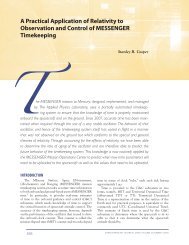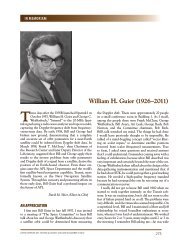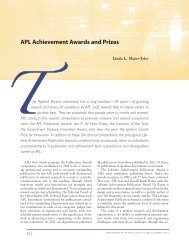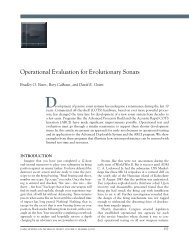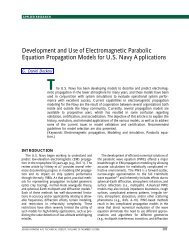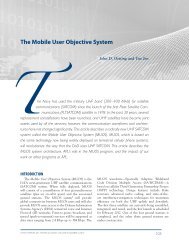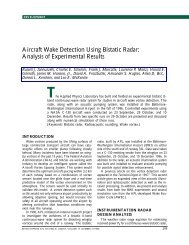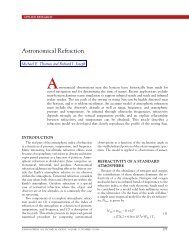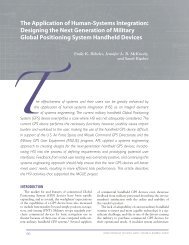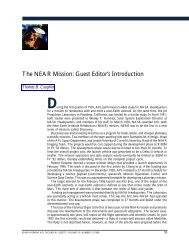The SATRACK System: Development and Applications
The SATRACK System: Development and Applications
The SATRACK System: Development and Applications
You also want an ePaper? Increase the reach of your titles
YUMPU automatically turns print PDFs into web optimized ePapers that Google loves.
THE AUTHORS<br />
THOMAS THOMPSON received a B.S.E.E. degree from Lafayette College in<br />
1960 <strong>and</strong> an M.S.E.E. degree from <strong>The</strong> Johns Hopkins University in 1968. He<br />
is a member of APL’s Principal Professional Staff in the Strategic <strong>System</strong>s<br />
Department. He joined APL’s Space Department in 1960 <strong>and</strong> served as a group<br />
supervisor, a branch supervisor, <strong>and</strong> the chief engineer. Mr. Thompson<br />
participated in a wide range of satellite development activities before becoming<br />
the lead system engineer for <strong>SATRACK</strong> development in 1973. In 1983, he<br />
joined <strong>System</strong> Planning Corporation, where he led the development of<br />
specialized radar instrumentation before returning to APL in 1992. At APL, he<br />
has led the development of important upgrades to the <strong>SATRACK</strong> system for<br />
Trident reentry body flight test evaluations, <strong>and</strong> IR&D activities to demonstrate<br />
new GPS measurement capability for missile intercept evaluations. His e-mail<br />
address is thomas.thompson@jhuapl.edu.<br />
LARRY J. LEVY is the Chief Scientist of APL’s Strategic <strong>System</strong>s Department.<br />
He received his Ph.D. in electrical engineering from Iowa State University in<br />
1971. Dr. Levy has worked on applied Kalman filtering for over 30 years. He was<br />
the co-developer of the GPS translator concept in <strong>SATRACK</strong> (a GPS-based<br />
missile tracking instrumentation system) <strong>and</strong> was instrumental in developing<br />
the end-to-end methodology for Trident II accuracy evaluation. He teaches<br />
graduate courses in Kalman filtering <strong>and</strong> system identification at <strong>The</strong> Johns<br />
Hopkins University Whiting School of Engineering <strong>and</strong> Kalman filtering<br />
seminars for Navtech Seminars. His e-mail address is larry.levy@jhuapl.edu.<br />
EDWIN E. WESTERFIELD attended the University of Maryl<strong>and</strong> where he<br />
received a B.S.E.E. degree in 1952 <strong>and</strong> an M.S.E.E. degree in 1963. He is a<br />
member of APL’s Principal Professional Staff in the Strategic <strong>System</strong>s<br />
Department. He joined APL in 1954 <strong>and</strong> was involved with development of the<br />
Talos guidance system <strong>and</strong> led the development of a large telemetry facility. In<br />
1960 he transferred to the Space Department, where he led the development of<br />
a relative navigation system using signals from the Navy Navigation Satellite<br />
<strong>System</strong>. On initiation of the <strong>SATRACK</strong> program, he became responsible for the<br />
development of much of the hardware <strong>and</strong> also served as a group supervisor. He<br />
transferred to the Strategic <strong>System</strong>s Department in 1990, where he is Group<br />
Supervisor of the <strong>SATRACK</strong>/GPS <strong>System</strong>s Group. Mr. Westerfield serves as the<br />
Program Manager of the National Missile Defense Precision Missile Tracking<br />
Program <strong>and</strong> of the GPS Range <strong>Applications</strong> Joint Program. His e-mail address<br />
is edwin.westerfield@jhuapl.edu.<br />
THE <strong>SATRACK</strong> SYSTEM<br />
JOHNS HOPKINS APL TECHNICAL DIGEST, VOLUME 19, NUMBER 4 (1998) 447




